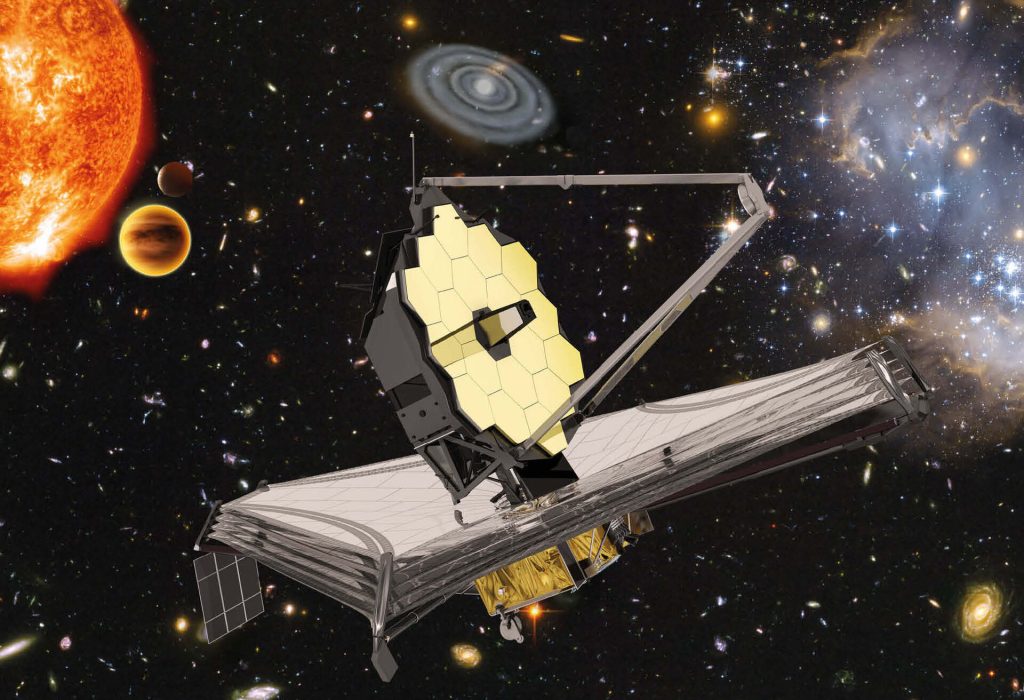James Webb Space Telescope- The largest Telescope in History

The James Webb Space Telescope is the largest telescope in history. The telescope was launched on December 25, 2021, from Europe’s spaceport in French Guiana in partnership with the European Space Agency and the Canadian Space Agency. It is named after James Webb, the second administrator of NASA, who has led many science missions of NASA. On its journey, the telescope has to complete a difficult mechanical maneuver: assembling itself. As the telescope is very large, it needed to launch folded up inside a rocket. Over the course of several weeks, it needs to unfurl its various components from its sunshield to its mirrors.
NASA’s largest and most powerful space science telescope will probe the cosmos to uncover the history of the universe from the Big Bang to alien planet formation and beyond. It is one of NASA’s great observatories, huge space instruments that include the likes of the Hubble Space Telescope to peer deep into the cosmos. It will take about 30 days for the James Webb Space Telescope to travel nearly a million miles (1.5 million kilometers) to its permanent home: a Lagrange point – a gravitationally stable location in space. The James Webb Space Telescope will orbit the sun at the second Lagrange point (L2).
According to NASA, the James Webb Space Telescope will focus on the main four areas: first light in the universe, assembly of galaxies in the early universe, the birth of stars, and protoplanetary systems and planets. Once the JWST has launched, It will undergo a series of science and calibration tests including sunshield deployment, telescope deployment, instrument turn-on, and telescope alignment. According to the Space Telescope Science Institute, the best image from JWST will start to appear about six months after launch. Though we may possibly be treated to some “first light” image slightly earlier. It is also expected to take amazing photos of celestial objects like its predecessor, the Hubble Space Telescope.
The James Webb Space Telescope is the product of an impressive International Collaboration between NASA, the European Space Agency, and the Canadian Space Agency. According to NASA, the JWST involved over 300 universities, organizations, and companies across 29 US states and 14 countries. The nominal duration for the James Webb Space Telescope is about five years but the goal is ten years, as per ESA.
The James Webb Space Telescope is principally divided among four areas:
- First light and reionization: This refers to the early stage of the universe after the Big Bang started the universe as we know it today. In the first stage, the universe was a sea of particles, such as electrons, protons, and neutrons, and the light was not visible until the universe cooled enough for these particles to begin combining.
- Assembly of galaxies: The James Webb Space Telescope’s unprecedented infrared sensitivity will help astronomers to compare the faintest, earliest galaxies to today’s grand spirals and ellipticals, helping us to understand how galaxies assemble over billions of years.
- Birth of stars and protoplanetary systems: JWST will be able to see right through and into massive clouds of dust that are opaque to visible-light observatories like Hubble, where stars and planetary systems are being born.
- Planets and origins of life: JWST will tell us more about the atmospheres of extrasolar planets and perhaps even find the building blocks of life elsewhere in the universe. In addition to other planetary systems, JWST will also study objects within our own Solar System.
For getting all the updated news about James Webb Space Telescope, you may subscribe to Sky and Telescope Magazine as it covers all astronomy events on a monthly basis. This will provide you with all the current updates regarding the journey of the James Webb Space Telescope.


